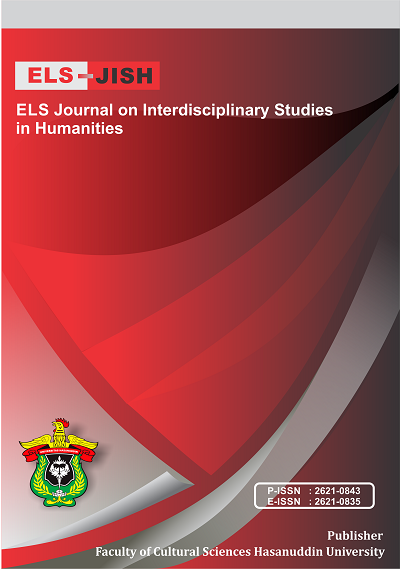The Function of Proverbs as Educational Media: Anthropological Linguistics on Wolio Proverbs
DOI:
https://doi.org/10.34050/els-jish.v3i2.10505Keywords:
Proverbial Function, Anthropological Linguistics, WolioAbstract
This study aims to explain the function of proverbs as an educational media in the socio-cultural life of Wolio people in Southeast Sulawesi. The method used in this study was a descriptive qualitative in anthropological linguistics perspective. Data collected through observation and in-depth interviews. Data analysis departs from language analysis and then cultural analysis. This study concludes that Wolio proverb as an educational medium has five important functions in the social life of Wolio people, namely as a means to: (1) teach linguistic knowledge, (2) train the performance of Wolio young people in speaking, (3) instill values wisdom for young people, (4) controlling young people's behavior to conform to agreed norms, and (5) educating Wolio youths to own and uphold their life principles. From these findings, this study confirms that proverbs are a good educational medium because they contain linguistic knowledge and positive cultural values so that they must be kept and preserved by their supporting communities. The role of the government is very important to support the preservation of this proverb.
References
Abas, Husen A., Kadir Manyambeang, Ibnu Nandar, Shaidy. (1983). Struktur Bahasa Wolio. Jakarta: Pusat Pembinaan dan Pengembangan bahasa, Departemen Pendidikan dan Kebudayaan.
Anceaux, J.C. (1985). The Wolio Language: Outline of Grammatical Descriptions and Text. Netherland: Foris Publications Holland.
Arewa, E. Ojo dan Alan Dundes. 1964. “Proverb and Ethnography of Speaking Folklore”. American Anthropologist, New Series 66 (6): 70-85.
Arief, Aburaerah dan M. N. Haddade, A.K. Mulya.(1992). Kamus Ungkapan Wolio-Indonesia. Jakarta: Pusat Pembinaan dan Pengembangan Bahasa , Dep. Pendidikan dan Kebudayaan.
Arimi, Sailal. (2016). Peribahasa Indonesia: Kajian Kategorisasi, Struktur, dan Vitalitasnya (Doctoral dissertation). Retrieved from http://digilib.fib.ugm.ac.id/digital/list_by/7/130.
Bateson, Gregory. 1972. Steps to an Ecology of Mind. New York: Ballatine.
Bergsma, Harold M. 1970. “Tiv Proverb as A Means of Social Contro”. Journal of The International African Institute 40 (2): 151-163.
Danesi, Marcel. 2004. A Basic Course In Anthropological Linguistics. Toronto: Canadian Scholars’ Press Inc.
Djawanai, Stephanus.(2009). Telaah Bahasa, Telaah Manusia (pidato pengukuhan jabatan guru besar dalam Ilmu Linguistik pada Fakultas Ilmu Budaya UGM). Yogyakarta: FIB UGM.
Ethnoloque Languange of The World. (2016).Bahasa Wolio. https://www.ethnologue.com.language/wlo. Diakses hari sabtu tanggal 26 Oktober 2016, Pukul 10.30.
Foley, William A. (2001). Anthropological Linguistics; An Introduction. Oxford: Blackwell.
Gokhan, Asli. (1992). What Have the Ancestor Said: An Ethnography of Speaking Proverb in a Turkish Community. Dissertation. Oakland: Universitas Pittsburg.
Gusdorf, Georges. 1965. Speaking (La Parole). Diterjemahkan oleh Paul T. Brockelman. Evanston, III: Northwestern University Press.
Hamzah, Zaitul Azma Hasan dan Ahmad F.M. Hasan. (2011). “ Bahasa dan Pemikiran dalam Peribahasa Melayu” dalam GEMA Online of Languange Studies, 11 (3): 31-50.
Hendrokumoro. (2016). Peribahasa Jawa (Doctoral dissertation). Retrieved from. Disertasi. http://digilib.fib.ugm.ac.id/digital/list_by/7/120.
Hymes, D. 1972. “Toward Etnographies of Communication: The Analysis of Communicative Events”. Dalam P. Paolo Giglioli (Ed). Language and Social Context,. England: Penguin Group KBBI. (2005). Pusat Bahasa. Edisi Keempat. Jakarta: PT Gramedia Pustaka Utama
Kramsch, Claire.(1998). Language and Culture.Oxford: Oxford University Press.
Laal, M. (2011). Lifelong learning: What does it mean?, Social and Behavioral Sciences 28 (2011) 470 – 474.
Leech, Geoffrey. 2003. Semantik. Yogyakarta: Pustaka Pelajar.
Loeb, Edwin. (1952). “The Function of Proverbs in The Intellectual Development of Primitive Peoples” dalam The Scientific Monthly, 74 (2): 100-104.
Mahali, Saidatul Nornis H. dan Saamah Mohd. Rasdi. 2013. “Haiwan Sebagai Perlambangan dalam Peribahasa Orang Semai”. GEMA Online of Languange Studies 13 (1): 83-98.
Mansyur, F.A. (2018). Onina Manga Mancuana Mangenge: Ungkapan Tradisional Orang Wolio (Doctoral dissertation). Retrieved from. http://digilib.fib.ugm.ac.id/digital/filter/960.
Mansyur, F.A. (2020). A Cognitive Semantics Analysis of Wolio Proverbs Related to the Human Body, Advances in Social Science, Education and Humanities Research, volume 436, Published by Atlantis Press SARL. Retrieved from https://www.atlantis-press.com/proceedings/bis-hess-19/articles.
Nopiah, J.Binti, N. H Binti Jalaluddin, dan J.Binti Kasdan. 2017. “Refleksi Dualisme ‘Durian-Timun’ dalam Peribahasa Melayu: Pendekatan Semantik Inkuistif”. Jurnal Linguistik 21 (2):1-14.
Pusat Bahasa. (2005). Bahasa-Bahasa di Indonesia. Dendy Sugona, Mahsun, Inyo Yos Fernandez, Kisyani Laksono, Multamia Lauder, dan Nadra (Ed). Jakarta: Pusat Bahasa, Departemen Pendidikan Nasional.
Sapir, Edward. 1928. “The Voice of Africa: Some Gweabo Proverbs”. International African Institute 2 (2): 183-185.
SIL. (2006). Bahasa-Bahasa di Indonesia. Jakarta: SIL International.
Spradley, J.P. (1997). Metode Etnografi. Yogyakarta: Tiara Wacana Yogyakarta.
Suhandano. (2004). Klasifikasi Tumbuh-Tumbuhan dalam Bahasa Jawa: Sebuah Kajian Linguistik Antropologis (Unpublished doctoral dissertation). Universitas Gadjah Mada. Yogyakarta, Indonesia.






